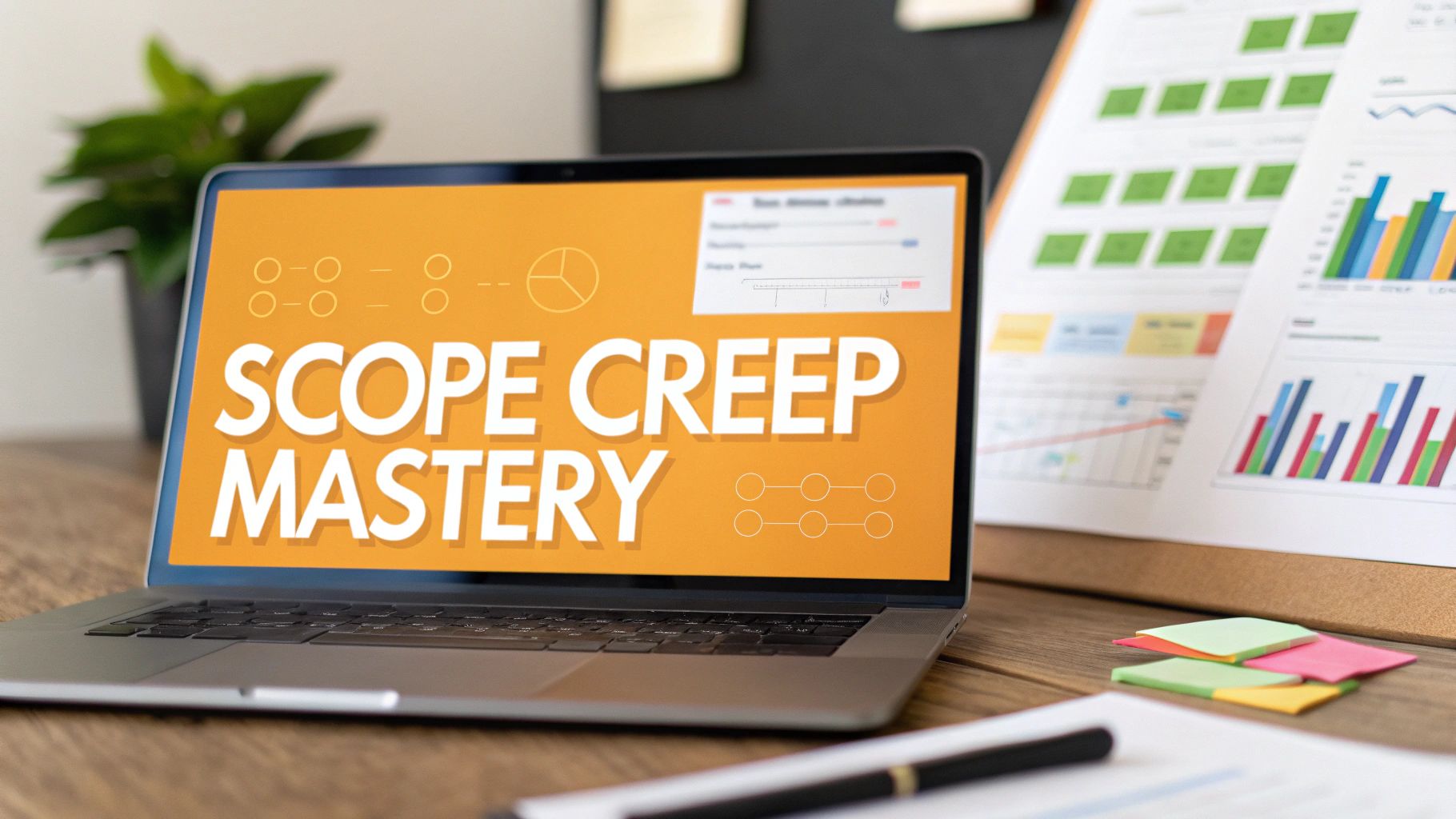"Thought leadership." The phrase gets thrown around so often it’s practically lost all meaning. It’s become a corporate buzzword for just about any blog post or LinkedIn update with a strong opinion. But true thought leadership is more than just shouting into the digital void; it’s about creating content that genuinely shifts perspectives, introduces new ideas, and establishes you or your brand as the go-to authority in a specific niche. It’s what separates fleeting attention from lasting influence.
So, how do you move beyond the buzzwords and create content that actually leads? You study the best. This isn't just another list of generic advice. We’re diving deep into real-world thought leadership content examples that have made a significant impact. We’ll dissect what makes them work, from their core strategy to the specific tactics they used to capture an audience's attention and trust.
Forget vague success stories. Instead, you'll get a tactical breakdown of each example, covering everything from original research reports and authoritative articles to podcasts and viral social media threads. Our goal is to give you a replicable blueprint. By the end of this article, you’ll have a clear understanding of the mechanics behind powerful thought leadership and a toolbox of actionable strategies you can apply to your own content, starting today. Let's get straight to the examples.
1. Original Research Reports and Industry Studies
Nothing says "we know our stuff" quite like publishing a comprehensive research report packed with fresh, original data. This is the heavyweight champion of thought leadership content examples. Instead of just commenting on industry trends, you're the one creating the data that defines them. This approach involves conducting proprietary surveys, analyzing the findings, and presenting them in a polished, professional report.
These reports, like HubSpot’s annual State of Marketing Report or the highly-respected Edelman Trust Barometer, become go-to resources for journalists, analysts, and other businesses. They get cited in articles, mentioned in keynotes, and shared across social media, cementing your brand as a definitive authority. It's a high-effort, high-reward strategy that builds a powerful moat of credibility around your brand.
Why It Works: The Strategy Breakdown
Original research is powerful because it's exclusive. You own the data. Anyone who wants to talk about your findings has to mention you, generating valuable backlinks and brand mentions. This creates a ripple effect, positioning you at the center of the industry conversation.
Furthermore, it directly addresses your audience's most pressing questions with hard data, not just opinions. It’s the difference between saying "we think customer retention is important" and "our study of 5,000 businesses shows that a 5% increase in customer retention can increase profitability by 25%." The second statement is infinitely more powerful and shareable.
This short video from HubSpot breaks down how they leverage their own research reports to fuel their content engine for an entire year.
Quick Reference: Anatomy of a Research Report
To get a clearer picture, here's a quick summary of what makes up a high-impact research report.
As the breakdown shows, the combination of unique data and professional presentation is key, but it demands a significant investment of time and resources to execute properly.
How to Implement This Strategy
Feeling inspired but a little intimidated? Don't be. You don't need a massive budget to get started.
- Start Small: Survey your own customer base or email list first. This data is highly relevant and accessible, providing insights your competitors can't replicate.
- Find a Niche: Instead of tackling a huge topic like "The Future of AI," focus on a specific, unanswered question within your industry, such as "How are small e-commerce businesses using AI for inventory management?"
- Plan a Multi-Channel Launch: Your report is the main event, but it needs a supporting cast. Promote it with a webinar, blog posts summarizing key findings, infographics, and a social media campaign. Squeeze every drop of value from your hard work.
2. Long-Form Authoritative Blog Posts and Articles
If original research is the heavyweight champion, then long-form authoritative blog posts are the seasoned grandmasters. These aren't your typical 500-word blurbs. We're talking deep, comprehensive articles (often 2,000-5,000+ words) that tackle a complex topic from every angle, leaving no stone unturned. This is where you establish yourself as a true teacher and guide in your field.

Think of the detailed SEO guides from Brian Dean at Backlinko or the wonderfully quirky, yet incredibly insightful, posts from Tim Urban at Wait But Why. These pieces become pillar content that people bookmark, reference for years, and share widely. They are evergreen assets that continuously attract traffic, build trust, and demonstrate an unparalleled depth of expertise.
Why It Works: The Strategy Breakdown
Long-form content works because it signals generosity and mastery. By investing the time to create a definitive resource on a topic, you're not just sharing an opinion; you're providing immense value for free. This builds incredible goodwill and positions you as the go-to expert who truly understands the subject inside and out.
Furthermore, this type of content is a magnet for search engines. Google's algorithms favor in-depth, high-quality content that thoroughly answers a user's query. A well-crafted authoritative post can rank for dozens of long-tail keywords, becoming a powerful, long-term driver of organic traffic. It’s a foundational piece of any strong content marketing strategy guide. This approach transforms your blog from a simple publication into an essential industry library.
Quick Reference: Anatomy of a Long-Form Post
Here’s a snapshot of the essential ingredients that make a long-form article a powerful thought leadership content example.
- Word Count: Typically 2,000-5,000+ words
- Structure: Clear headings, subheadings, bullet points, and visuals to improve readability
- Content: A mix of original ideas, actionable advice, data, examples, and unique frameworks
- Goal: To be the most comprehensive and valuable resource on a specific topic
This format is demanding but delivers lasting authority and search visibility, making it a cornerstone for serious thought leaders.
How to Implement This Strategy
Creating a massive post from scratch can feel daunting. Here’s how to make it manageable and effective.
- Answer a Big Question: Start with a significant, recurring question your customers or audience asks. Your goal is to create the single best answer to that question on the internet.
- Create an Original Framework: Don't just regurgitate common advice. Develop your own unique model, acronym, or step-by-step process. This makes your content distinct and more memorable.
- Use the "Skyscraper" Technique: Find the best-performing content on your chosen topic and then create something significantly better. Add more detail, include newer data, provide better visuals, and offer more actionable takeaways.
- Plan for Readability: Break up your text! Use short paragraphs, bold text, images, blockquotes, and custom graphics. A wall of text, no matter how brilliant, will scare readers away.
3. Books and E-books
If an original research report is the heavyweight champion, writing a book is like earning a lifetime achievement award. It's the ultimate credibility signal, transforming you from an industry participant into an industry-defining voice. A book provides the space to develop a comprehensive framework, share a groundbreaking methodology, or tell a story that shapes your entire field.
Think of books like The Lean Startup by Eric Ries or Simon Sinek's Start With Why. These works didn't just share ideas; they created movements and new professional vocabularies. Publishing a book, whether traditional or digital, is a powerful move that serves as a permanent, high-value business card. It opens doors to speaking engagements, high-level consulting, and media features, solidifying your status as a go-to expert.
Why It Works: The Strategy Breakdown
A book is powerful because it represents depth and commitment. In a world of fleeting blog posts and 280-character thoughts, a book demonstrates that you have invested significant time to explore a topic with nuance and thoroughness. It's a tangible asset that can't be easily replicated, giving your ideas a sense of permanence and authority.
This format allows you to create a proprietary framework or model that becomes synonymous with your name. It’s the difference between tweeting "build products people want" and writing the definitive guide on the build-measure-learn feedback loop, as Eric Ries did. Your book becomes the primary source, the foundational text others reference, debate, and build upon, placing you at the epicentre of the conversation.
Quick Reference: Anatomy of a Thought Leadership Book
To get a clearer picture, here’s a quick summary of what makes up a high-impact thought leadership book.
As the breakdown illustrates, the core idea must be strong and the execution professional. It's a long-term play that requires dedication but offers unparalleled returns in authority and influence.
How to Implement This Strategy
The idea of writing a book can feel monumental, but it's more achievable than ever. Here’s how to start.
- Start with a "Minimum Viable Book": Begin with an e-book. Compile a series of popular blog posts or LinkedIn articles into a cohesive guide. This allows you to test your core ideas and build an audience before committing to a full-length print book.
- Define Your Unique Framework: What is your "one big idea"? Is it a new process, a contrarian viewpoint, or a mental model? A memorable, shareable framework like "Crossing the Chasm" or the "Hook Model" is what makes a book stick.
- Build Your Launch Team Early: Don't wait until the book is written to start marketing. Build an email list by offering a free chapter or related resources. Connect with other influencers in your space who can help promote the book to their audiences upon release. This pre-launch buzz is critical for a successful debut.
4. Video Thought Leadership Series
In an increasingly visual world, video has become a powerhouse for conveying expertise and personality simultaneously. A video thought leadership series involves regularly publishing content that shares expert insights, analysis, and perspectives. This format is incredibly versatile, ranging from a solo expert talking to the camera to in-depth interviews with other industry leaders.
Platforms like YouTube and LinkedIn are ideal for this, as they combine powerful distribution with community-building features. Great examples include Rand Fishkin's classic Whiteboard Friday, which visually broke down complex SEO topics, or Marie Forleo’s highly-produced MarieTV. These series don't just share information; they build a loyal following by putting a face and a voice to the expertise, creating a much stronger connection than text alone.
Why It Works: The Strategy Breakdown
Video's power lies in its ability to build trust and connection at scale. Viewers can see your expressions and hear your tone of voice, which creates a sense of personal connection that’s difficult to replicate in writing. This human element makes your insights more memorable and your brand more approachable.
Furthermore, video excels at simplifying complex topics. Instead of just describing a process, you can show it. Instead of quoting an expert, you can have a conversation with them. This dynamic format holds attention longer and can make dense information feel accessible and engaging. It’s the difference between reading a manual and having a mentor guide you step-by-step.
How to Implement This Strategy
Worried you need a Hollywood-level production studio? You don't. The key is consistency and valuable insights, not a massive budget.
- Start Simple: Use your smartphone to test concepts. Focus on good lighting and clear audio. The authenticity of a simple setup can be more relatable than a slick, overproduced video.
- Focus on One Idea: Each video should have a single, clear takeaway. Avoid the temptation to cover everything at once. A five-minute video that solves one specific problem is far more effective than a 30-minute video that tries to solve ten.
- Create a Recognizable Format: Develop a consistent structure, opening, or style. This helps build a brand for your series and lets your audience know what to expect, encouraging them to subscribe and tune in regularly. For guidance on getting your content seen, especially on key professional networks, check out our guide on how to post a video on LinkedIn.
- Engage with Your Community: The comment section is a goldmine. Actively respond to comments and questions to build a loyal community and source ideas for future content.
5. Podcasts and Audio Content
Podcasting has evolved from a niche hobby into a mainstream medium for establishing authority. This thought leadership content example allows you to literally speak directly to your audience, creating a uniquely intimate and engaging connection. Instead of just reading your words, listeners hear your voice, your passion, and your expertise during their commute, at the gym, or while doing chores.
This format excels at building a loyal, long-term audience. Shows like Reid Hoffman's Masters of Scale or Guy Raz's How I Built This have become essential listening for entrepreneurs and business leaders. They aren't just one-off pieces of content; they are ongoing conversations that build trust and anticipation episode after episode. It's a powerful way to own a space in your audience's daily routine.
Why It Works: The Strategy Breakdown
Audio content thrives because it's passive and personal. Your audience can absorb your insights while multitasking, making it incredibly convenient. Unlike a blog post or video that demands full attention, a podcast can be a constant companion, building a relationship through consistent, valuable conversation directly in your listener's ear.
This medium also allows for incredible depth. A 45-minute interview can explore nuances and stories that a 1,000-word article simply can't capture. It’s the difference between summarizing an expert’s advice and hearing them tell the story behind it, complete with inflection and emotion. That authentic, unscripted feel is what transforms a brand from a faceless entity into a trusted guide.
Quick Reference: Anatomy of a Thought Leadership Podcast
To get a clearer picture, here's a quick summary of what makes up a high-impact podcast.
- Distinctive Niche: A focused topic that attracts a specific, dedicated audience (e.g., The Knowledge Project on mental models).
- Unique Format: A consistent structure listeners recognize, like deep-dive interviews, solo monologues, or narrative storytelling.
- High-Quality Audio: Clear, professional sound that makes listening easy and enjoyable.
- Consistent Schedule: A reliable publishing cadence (weekly, bi-weekly) that builds a habit with your audience.
- Actionable Insights: Each episode delivers value, giving listeners practical takeaways they can apply.
As the breakdown shows, a successful podcast is more than just talking into a microphone. It requires a clear strategy, a commitment to quality, and a consistent delivery schedule to build and maintain an audience.
How to Implement This Strategy
Ready to grab the mic? You don't need a professional studio to create a compelling podcast.
- Define Your Niche: Don't try to create a generic "business" podcast. Instead, focus on a specific pain point or interest. For example, instead of "Marketing Tips," try "Marketing for B2B SaaS Founders in Their First Three Years."
- Invest in a Good Mic: You can get a high-quality USB microphone for under $150. Good audio quality is non-negotiable and is the single biggest factor in perceived professionalism.
- Batch Your Recordings: Set aside one day to record several episodes at once. This ensures you maintain a consistent publishing schedule even when you get busy.
- Repurpose Everything: Your podcast is a content goldmine. Turn one episode into a summary blog post, a series of quote graphics for social media, a short video clip for LinkedIn, and an audiogram to promote the full episode.
6. Speaking Engagements and Conference Presentations
Stepping onto a stage, whether physical or virtual, and commanding a room's attention is a classic and powerful form of thought leadership. This format takes your expertise out of the digital realm and puts it directly in front of a live audience. Instead of readers consuming your content alone, you create a shared, memorable experience that builds a powerful, personal connection.
From iconic keynotes like Steve Jobs’ iPhone launch to the viral impact of a great TED Talk, speaking engagements cement your authority in a highly visible way. These presentations, like Simon Sinek’s legendary "Start With Why", become evergreen assets that can be recorded and shared, massively amplifying your reach far beyond the people who were in the room. This is a high-impact, high-visibility strategy for leaders who are comfortable in the spotlight.
Why It Works: The Strategy Breakdown
Speaking engagements are powerful because they are performative. They combine intellectual authority with human connection, emotion, and storytelling. An audience doesn't just hear your ideas; they experience them through your voice, your presence, and your passion. This creates a much deeper and more lasting impression than a written article alone.
Furthermore, getting booked for a respected conference provides instant third-party validation. The event organizers have vetted you, placing their stamp of approval on your expertise. This borrowed credibility immediately elevates your status. It’s the difference between saying "I'm an expert" and having the organizers of a major industry event say "This is an expert you need to hear from."
Quick Reference: Anatomy of a Powerful Presentation
To understand what elevates a simple speech to a thought leadership moment, here's a summary of its core components.
As the breakdown illustrates, the most effective presentations are a carefully crafted blend of personal storytelling, data-backed insights, and a polished delivery that feels both authentic and authoritative.
How to Implement This Strategy
Ready to take the stage but not sure where to start? You don't need a TED invitation to begin building your reputation as a speaker.
- Start Local: Look for opportunities at local industry meetups, Chamber of Commerce events, or even by offering to run a "lunch and learn" for a partner company. These are great, low-stakes environments to hone your message and delivery.
- Develop Your Signature Talk: Don't try to create a new presentation for every event. Instead, develop one core "signature" talk on your area of expertise and refine it over time. This makes your message consistent and allows you to perfect it through repetition.
- Record Everything: Always get a recording of your talk, even if it's just on a smartphone. This content can be repurposed into clips for social media, a full-length YouTube video, a podcast episode, and blog post summaries, extending the life of your performance indefinitely.
7. Social media Thought Leadership
In today's fast-paced digital world, thought leadership has moved from the boardroom to the newsfeed. Social media thought leadership involves consistently sharing sharp insights, unique perspectives, and actionable expertise on platforms like LinkedIn, X (formerly Twitter), and even TikTok. Instead of waiting for a conference stage or a publication feature, experts can now build a direct, engaged audience through frequent, valuable posts.
This approach flips the traditional model on its head. It prioritizes brevity, authenticity, and consistent engagement over long-form, polished perfection. Think of figures like Adam Grant, whose LinkedIn posts on organizational psychology reach millions, or Justin Welsh, who built a multi-million dollar solopreneur business by openly sharing his journey and tactics. They became authorities not by publishing a single magnum opus, but through a steady stream of high-value, bite-sized content that solves real problems for their followers.

Why It Works: The Strategy Breakdown
Social media thought leadership is powerful because it's accessible and relational. It removes the barriers between the expert and the audience, creating a direct line for communication and community building. By showing up consistently where your audience already spends their time, you build trust and familiarity at a scale that traditional content can't match.
This strategy thrives on the feedback loop. Every comment, share, and question is immediate market research, telling you exactly what your audience cares about. This allows you to fine-tune your message and create content that resonates deeply. It's the difference between publishing a white paper and hoping it lands, versus posting an idea on LinkedIn and having a direct conversation with 200 potential customers about it in the comments.
How to Implement This Strategy
Getting started with social media thought leadership is less about having all the answers and more about being willing to share your journey and perspective consistently.
- Pick Your Platform: Don't try to be everywhere at once. Master one or two platforms where your target audience is most active. For B2B professionals, LinkedIn is often the best place to start. A strong profile is your foundation; understanding the elements of a good LinkedIn photo is a crucial first step to establishing credibility.
- Create a Content System: Consistency is king. Develop a simple system for capturing ideas and scheduling posts. Repurpose longer content like blog posts or podcast episodes into platform-specific formats like X threads, LinkedIn carousels, or short videos.
- Engage More Than You Post: The secret sauce is community. Spend time genuinely engaging with others in your niche. Answer questions, leave thoughtful comments, and share other people's valuable content. This builds relationships and puts your profile in front of new, relevant audiences. For more tips, check out this guide on how to get more connections on LinkedIn.
Thought Leadership Content Types Comparison
| Thought Leadership Type | Implementation Complexity 🔄 | Resource Requirements ⚡ | Expected Outcomes 📊 | Ideal Use Cases 💡 | Key Advantages ⭐ |
|---|---|---|---|---|---|
| Original Research Reports and Industry Studies | High: requires expertise in research methods and data analysis | High: significant time, budget, and design costs | Strong credibility, media coverage, and lead generation | B2B companies, consultancies, SaaS with unique data sets | Establishes authority; long-term reference value |
| Long-Form Authoritative Blog Posts and Articles | Medium: time-intensive research and writing | Medium: moderate time and content creation resources | SEO benefits, organic traffic, and personal brand growth | Consultants, agency leaders, executives developing personal brands | Cost-effective; quick publishing; SEO-friendly |
| Books and E-books | Very High: lengthy writing, editing, and publishing cycle | Very High: time-consuming and marketing-intensive | Ultimate credibility, passive income, and speaking opportunities | Executives, consultants, experts seeking definitive authority | Authoritative status; long shelf life |
| Video Thought Leadership Series | High: production, editing, and on-camera presence | High: equipment, editing time, and technical skills | Strong personal connections and high engagement | Leaders comfortable on camera building personal brands | High engagement; repurposable; favored by algorithms |
| Podcasts and Audio Content | Medium: recording and post-production commitment | Medium: microphone, software, and hosting costs | Loyal audience, intimate connection, episodic engagement | Conversational leaders leveraging guest networks | Lower cost than video; authentic insight delivery |
| Speaking Engagements and Conference Presentations | High: preparation, travel, and public speaking skills | Medium-High: travel, staging, and presentation materials | Memorable live impact and networking | Charismatic leaders with strong public speaking skills | High impact; direct audience influence |
| Social Media Thought Leadership | Low-Medium: requires high frequency and authenticity | Low: minimal investment beyond time | Fast audience growth and immediate feedback | Individual practitioners and leaders with limited budgets | Low barrier; direct engagement; rapid idea testing |
Putting It All Together: Your Thought Leadership Action Plan
We’ve just journeyed through a powerful lineup of thought leadership content examples, from groundbreaking original research to the charismatic pull of a well-produced video series. It’s a lot to take in, but the mission was simple: to demystify what actually works and hand you the strategic blueprint.
Looking back at the examples, a few core principles shine through. True thought leadership isn't about having all the answers. It’s about asking the right questions, challenging the status quo, and inviting your audience into a meaningful conversation. It's the difference between saying "Here's what I know" and asking "Here's what I see, what do you think?"
The Golden Threads of Great Thought Leadership
As you start building your own strategy, keep these fundamental takeaways from the examples we analyzed at the front of your mind. They are the common DNA shared by all impactful thought leaders.
- Authenticity is Non-Negotiable: Every standout example, whether from a massive corporation or a solo consultant, was deeply rooted in a genuine perspective. They weren't just regurgitating trends; they were sharing a unique viewpoint forged from real experience.
- Data Tells, Stories Sell: From original industry reports to personal anecdotes in a podcast, the most compelling content blends hard evidence with human connection. Numbers build credibility, but stories create a lasting emotional imprint.
- Consistency Compounds Impact: A single viral post is great, but a sustained presence is what builds a true following. The most respected thought leaders show up consistently, reinforcing their expertise and building trust over time, not overnight.
- Format Follows Function: The choice of medium was never random. The best examples showed a deep understanding of their audience, meeting them where they are with the format that best suits the message, be it a detailed e-book or a quick-hitting LinkedIn video.
Your Immediate Next Steps
Feeling inspired? Good. Now, let’s channel that energy into action. Don’t try to do everything at once. Pick one or two formats that align with your strengths and your audience's preferences.
- Identify Your Niche Within a Niche: What specific, underserved question can you answer better than anyone else? Instead of "marketing," think "retention marketing for SaaS startups under $5M ARR." Get specific.
- Commit to One Primary Platform: Choose your battlefield. Will you dominate LinkedIn with insightful articles? Build an audience with a weekly podcast? Focus your energy to gain traction faster.
- Create Your "Pillar" Piece: What is the one major piece of content you can create that will serve as the foundation for everything else? This could be your original research study, your authoritative guide, or the keynote presentation you perfect.
- Repurpose, Repurpose, Repurpose: Your pillar piece isn't a one-and-done asset. Break it down. Turn report findings into a dozen social media posts, a blog article, and a podcast episode. Maximize the value of every effort.
Mastering these approaches isn't just about building a personal brand or generating leads, although it certainly helps with both. It’s about earning a seat at the table where the future of your industry is being discussed. It’s about becoming a trusted resource, not just another vendor. To further inspire your content strategy, explore these 8 potent thought leadership content examples for B2B leaders for more ideas.
Ultimately, the journey from expert to thought leader is a marathon, not a sprint. The examples we’ve explored prove that with a clear point of view and a commitment to delivering genuine value, you can build an influential voice that truly matters. So, what’s the first step you’re going to take today?
Ready to scale your content creation without sacrificing quality or authenticity? RedactAI is a powerful AI writing tool designed to help you generate high-quality drafts, brainstorm unique angles, and overcome writer's block. Use RedactAI to turn your core ideas into compelling thought leadership pieces faster than ever before.






















































































